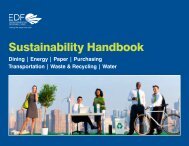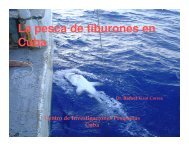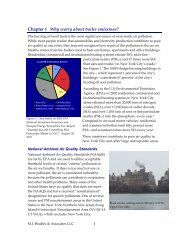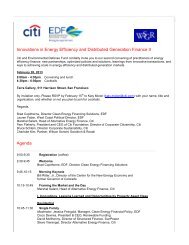Annotated bibliography [PDF] - Environmental Defense Fund
Annotated bibliography [PDF] - Environmental Defense Fund
Annotated bibliography [PDF] - Environmental Defense Fund
Create successful ePaper yourself
Turn your PDF publications into a flip-book with our unique Google optimized e-Paper software.
61. Gislason, GS, 2002. BC Seafood and Recreational Fishing SWOT. This report summarizesBC fisheries and their management regime, average crew size, vessels, average effort,and historical catch statistics (landings, value 1993-2002).62. Grafton, R., Nelson, H., Turris, B. 2004. How to Resolve the Class II Common PropertyProblem? The Case of the British Columbia’s Multi-Species Groundfish Trawl. Report addressesmany issues surrounding the BC groundfish trawl fishery including history, IVQmanagement details, historical catch, discards, quota pricing and trawl effort. It is 20years since Munro and Scott identified the causes and possible remedies for thedissipation of rents in fisheries. We analyze one of the solutions proposed by Munroand Scott by using insights from the British Columbia multi-species groundfish trawlfishery that has used ITQs since 1997. The history of this fishery shows that even themost difficult management problems including by-catch, equity concerns, concentrationof quota holdings and vessel overages can be mitigated with the appropriate mix ofincentives, monitoring and enforcement.63. Groundfish Trawl Special Industry Committee, 1999. Review of the Groundfish TrawlIndividual Vessel Quota/Groundfish Development Authority Plan. http://www-ops2.pac.dfompo.gc.ca/xnet/content/groundfish/GFTrawl/paper.pdf.The Individual Vessel Quota/ Groundfish Development Authority (IVQ / GDA) plan, introduced in April 1997,brought wholesale change to the groundfish trawl industry. The terms of the IVQ /GDA plan were arrived at after a lengthy process including public consultations,meetings with the Groundfish Trawl Advisory Committee (GTAC), and the formationof the Groundfish Trawl Special Industry Committee (GSIC) to develop the details ofthe plan. The plan, as implemented, represented a formal agreement between GSICsignatories – an agreement arrived at after negotiation and compromise by thefishermen, processor, union, community, and government representatives comprisingthe sub-committee. Seeking to achieve conservation, economic, and social objectives,the plan contained unique and innovative provisions. While attempting to restore thefishery to economic viability and a sound conservation footing, the plan also sought toallow a “controlled” rationalization of the fleet, while avoiding the pitfalls associatedwith other IVQ plans. Of particular concern at the time of plan implementation was thepotential negative impact of allowing quota to be freely transferred between vessels:widespread quota “leasing” and undue quota concentration. In order to allow industryparticipants time to adjust their initial quota holdings to their desired “long term”package – whether this meant buying, selling, trading, specializing, regionalizing, etc. –one-way quota transfers were to be permitted for a two-year transitional period. After2½ years under the IVQ / GDA system, the groundfish industry has had anopportunity to adapt and adjust its operating practices to the plan. While sufficientexperience with the plan has been gained to allow a reasonable evaluation to beconducted, the plan is still new enough that its every provision has not yet becomeentrenched in industry’s daily routine. The prospect of a moratorium on quota transferslooms large in the industry. The fall of 1999 therefore provides a timely opportunity forreview of the IVQ / GDA plan.64. Gulf of Mexico Fishery Management Council (GMFMC), 2004. Final Amendment 15 tothe Fishery Management Plan for Coastal Migratory Pelagic Resources in the Atlantic and Gulf of- 10 -


![Annotated bibliography [PDF] - Environmental Defense Fund](https://img.yumpu.com/50613332/10/500x640/annotated-bibliography-pdf-environmental-defense-fund.jpg)

![What do we mean by MSY? [PDF]](https://img.yumpu.com/49525661/1/190x245/what-do-we-mean-by-msy-pdf.jpg?quality=85)

![Print version [PDF] - Environmental Defense Fund](https://img.yumpu.com/46812189/1/190x201/print-version-pdf-environmental-defense-fund.jpg?quality=85)
![Mercury Alert: Cleaning up Coal Plants for Healthier Lives [PDF]](https://img.yumpu.com/45587786/1/190x143/mercury-alert-cleaning-up-coal-plants-for-healthier-lives-pdf.jpg?quality=85)


![Program Overview [PDF] - Environmental Defense Fund](https://img.yumpu.com/34005758/1/190x96/program-overview-pdf-environmental-defense-fund.jpg?quality=85)


